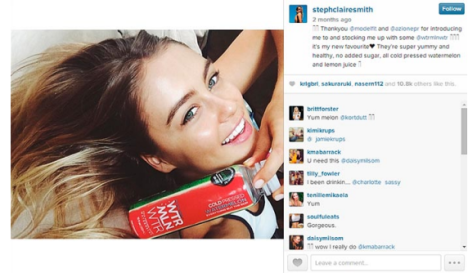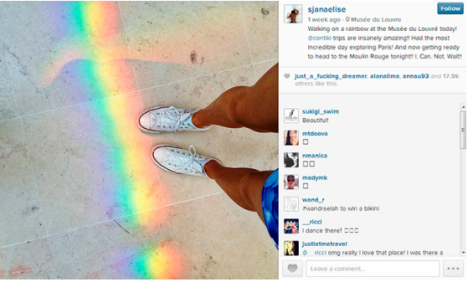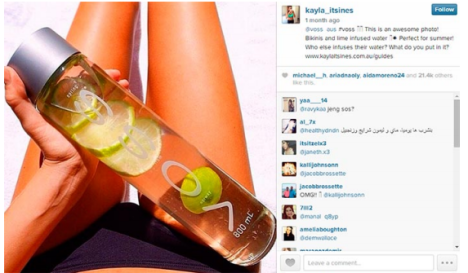The power of cool and product placement in social media
 Product placement is infiltrating social media influencers, but how long will it be before the platforms come for their piece of the pie asks Richie Meldrum?
Product placement is infiltrating social media influencers, but how long will it be before the platforms come for their piece of the pie asks Richie Meldrum?
Beauty and popularity have always gone hand in hand. If you think back to the most popular kid at your school, chances are, he or she was blessed with nice hair, clear skin and fortuitous features. Call it natural selection if you like, but the cool kids have courted the attention and admiration of their peers in a relationship dynamic that’s been going on as long as anyone can remember.
These days, things are different – there’s money to be made from being popular. In the online arena, certain individuals have been able to amass huge audiences via their social media accounts. Followers are attracted to their beauty, status and apparently enviable lifestyles, which they document, down to the finest detail, through regular posts and updates on social media accounts – most notably Instagram, Snapchat, YouTube and Tumblr.
A new breed of online celebrity, famous only within their own social media accounts (for now) continue to play an ever-increasing role in the lives of today’s notoriously elusive youth market. They court attention, evoke response and can influence behaviour. Not surprisingly, brands and businesses have quickly taken notice.
It’s always been tricky for advertisers to reach mass audiences in Australia.
Geographically, the country has the sixth largest landmass in the world, but in terms of population, it’s way down the line at number 53. The sheer distance between the major cities and the relatively small population makes running national campaigns hard.
Traditional media is either very general – the country only has one national print paper (the UK has seven) – or very tailored, with the various regional TV stations only able to speak to their own local audience. This means that brands have had to look for new ways to connect with national markets. This is especially true in the case of younger audiences who, more and more, are backing away from mainstream media consumption – when was the last time you saw a teenager reading a print magazine?
By tapping into the social media realm where huge numbers have congregated, advertisers are getting direct access to their target market. What’s more, they are doing so in a far more effective way than simply ramming their product in-between the entertainment the kids want to watch.
Taking advantage of the opportunities offered by the way the social media platforms work, the marketing, advertising and PR industries have essentially created a new form of product placement. However, rather than just showing Marty McFly drinking a Pepsi, or Daniel Craig sporting a Sunspel polo shirt as 007, the social media celebrities endorsing brands in their tweets, posts and videos, are willing and able to offer advertisers a much more blatant endorsement of their wares.
Jump online and check out the Instagram accounts of @kayla_itsines (currently sitting at 1.1 millions plus followers) @stephclairesmith (400k followers), or @sjanaelise, (also 400k+ followers) and countless others, and you’ll see what we are talking about. Peppered in between the photos of their ‘everyday lives’ are numerous examples of social media product placements. It could be a new skin care product they ‘swear by’, a new handbag they ‘love’ or a strategic post from a far-flung holiday destination in which that they just happen to mention the tour operator’s name and what an amazing time they are having.
Whatever the product, brand or service that is slipped into the mix, it always comes with a picture of said product and an ‘@’ mention, meaning anyone seeing the post can link through to the social media account of the company behind the placement, follow them and perhaps even click on the web link in the account and purchase said product.
First coming to prominence around 18 months ago through the social media accounts of people with large followings and a health or fitness focus to their content, social media product placement is now a well-established and oft used channel for the marketing industry. PR companies including Sweaty Betty have been quick to catch on to the opportunities offered by social media marketing and even started up an offshoot business called Ministry of Talent which represents ‘normal’ people who can wield influence over their followers.
However, according to some professionals working in the industry, being approached by company to promote their product through your social media account isn’t just about how many eyes you have access to.
“Followers are taken into consideration,” says Kate Patterson, an experienced social media manager “but these days the engagement rate is more important. Having 50k followers is great, but if only 500 of them are liking/interacting with the content then the account is not as valuable for a brand. It’s also important to assess whether the person is a good fit for the brand – tone of voice/age etc. Those would be the factors I’d take into consideration if I were to approach an influencer.”
As a new form of marketing and product placement, finding solid information on how it all works, including the commercial arrangements behind the deals, is hard.
Many people believe it works on a case by case basis. Often brands would want it to look like a genuine endorsement or a love for the product rather than a paid one. In most cases, brands or PR companies would send out the product to the individuals for free, hoping that this will be incentive enough for them to post it on their social media accounts. They would also provide the relevant brand accounts/handles and hashtags and the expectation would be that the individual would tag the brand page in their post. It’s likely that there would also need to be a discussion whether or not the individual would say that they’d been sent the product, or whether it would be made to look like they’ve chosen to wear or use it themselves.
In terms of monitoring the impact, again it’s hard to know. Analytical reporting on click-throughs in these situations is not provided. Therefore, as an advertiser, you’ve no way of knowing for sure what kind of cut-through you’ve achieved through social media product placement. However, there are some indicators. The more likes or comments there have been on the post, the more you know you’ve had an impact.
Likewise, if you see an increase in followers or an increase in sales then you might be able to point to your social media product placement as a factor.
One thing is for sure – if brands and businesses are using social media platforms to market their products without the owners of the platforms being able to take a cut, then you can bet your bottom dollar that plans are afoot to stop it when the time is right. As Instagram, Snapchat and other such channels move closer to fully monetising their business models with official advertising packages, the days of ‘under the radar’ product placement are numbered.
Until then, the popular kids will continue to be popular and the rest of us will continue to look at them in admiration.
Richie Meldrum is creative director at creative agency Yoke in Melbourne.







i dont understand
User ID not verified.